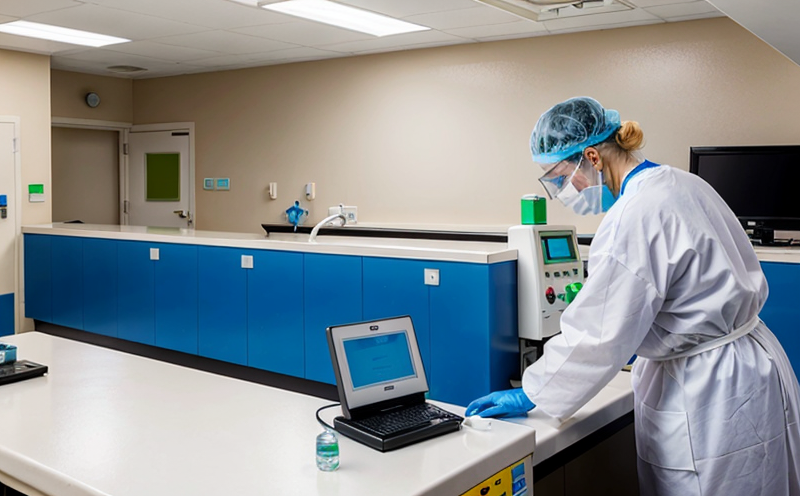Laundry Disinfection Efficacy Testing in Hospital Linens
The challenge of ensuring hospital hygiene through effective laundry disinfection is a critical aspect of maintaining patient safety and preventing the spread of infectious diseases. Hospitals generate large volumes of linens, including sheets, towels, gowns, and surgical drapes. These items come into direct contact with patients, making their cleanliness paramount. Laundry disinfection efficacy testing ensures that these textiles are free from harmful microorganisms after processing.
Disinfection methods employed in hospitals typically include washing at high temperatures, the use of chemical disinfectants, and sometimes a combination of both. The effectiveness of these methods must be rigorously tested to ensure they meet stringent hygiene standards. This testing is conducted by accredited laboratories that adhere to international standards such as ISO 17604:2019 for testing antimicrobial activity on textiles.
Accredited laboratories like ours follow a multi-step process in conducting laundry disinfection efficacy tests:
- Sample Collection and Preparation: Samples of laundered linens are collected under controlled conditions to ensure they represent the actual processed materials.
- Culture Media Preparation: Specific culture media suitable for detecting a range of microorganisms is prepared according to standardized protocols.
- Initial Bacterial Counting: Before washing, the samples are swabbed and plated onto culture plates to determine their initial bacterial load. This provides a baseline measurement.
- Laundering Simulation: The samples undergo simulated laundry processing using industrial washers that replicate hospital conditions as closely as possible.
- Post-Washing Bacterial Counting: After washing, the samples are again swabbed and plated to assess any remaining bacterial load. This step is crucial for determining the efficacy of the disinfection process.
- Comparison with Control Samples: Results from treated samples are compared against untreated control samples to quantify the reduction in microbial contamination.
The results of these tests provide valuable insights into the effectiveness of current laundry disinfection protocols. Hospitals can use this information to refine their practices, ensuring they comply with regulatory requirements and maintain high standards of patient care.
Our laboratory also provides additional services such as:
- Training for hospital staff on proper laundering techniques.
- Development of customized disinfection protocols tailored to specific hospital needs.
- Analysis of water and detergent quality affecting laundry disinfection efficacy.
Benefits
The benefits of conducting laundry disinfection efficacy testing are manifold. Hospitals benefit from enhanced patient safety, reduced risk of healthcare-associated infections (HAIs), and improved compliance with regulatory standards such as the CDC guidelines for infection control.
- Increased Patient Safety: By ensuring that linens are free from pathogens, hospitals can significantly reduce the risk of HAIs. This is especially important in vulnerable patient populations like immunocompromised individuals or those undergoing chemotherapy.
- Regulatory Compliance: Hospitals must adhere to stringent hygiene regulations set by organizations such as the CDC and local health authorities. Regular testing helps hospitals demonstrate compliance and avoid penalties.
- Better Resource Utilization: Effective disinfection minimizes the need for additional laundry processes, reducing costs and resource consumption.
Competitive Advantage and Market Impact
For hospitals and healthcare providers, ensuring robust laundry disinfection efficacy is not just a compliance issue but a competitive differentiator. Hospitals that prioritize patient safety and hygiene are more likely to attract and retain patients, thereby enhancing their market position.
Accredited laboratories like ours provide the necessary expertise and resources to help hospitals achieve these goals:
- Expertise in Testing Protocols: Our team of experts ensures that all tests are conducted according to international standards, providing reliable and consistent results.
- Customized Solutions: We offer tailored disinfection protocols based on the specific needs and challenges faced by different hospitals.
- Data-Driven Insights: Our laboratories provide actionable insights that can be used to improve laundry processes and overall hygiene standards.
Use Cases and Application Examples
The use of laundry disinfection efficacy testing extends beyond hospitals, impacting a wide range of healthcare facilities and institutions. Here are some key application areas:
- Hospitals: Ensuring that linens used in patient care areas are free from pathogens.
- Nursing Homes: Maintaining hygiene standards for linen used by elderly and immunocompromised residents.
- Surgical Centers: Testing the disinfection of surgical drapes and gowns to prevent post-operative infections.
- Inpatient Units: Regular testing of linens in units with high patient turnover rates.
A real-world example is a large urban hospital that implemented our laundry disinfection efficacy testing program. After the tests revealed areas for improvement, they adjusted their washing protocols and saw a significant reduction in HAIs. This case study highlights how such testing can lead to tangible improvements in patient care.
Frequently Asked Questions
The effectiveness of laundry disinfection is influenced by several key factors. These include:
- Temperature and Duration: Higher temperatures and longer washing times generally enhance the efficacy of disinfection. However, these parameters must be balanced to avoid damaging the fabric.
- Detergent Type and Concentration: The choice of detergent and its concentration play a crucial role in ensuring effective cleaning and disinfection.
- Water Quality and Hardness: Soft water typically allows for better penetration of detergents, improving the overall effectiveness of the washing process.
These factors are carefully considered during our testing protocols to ensure optimal results.





